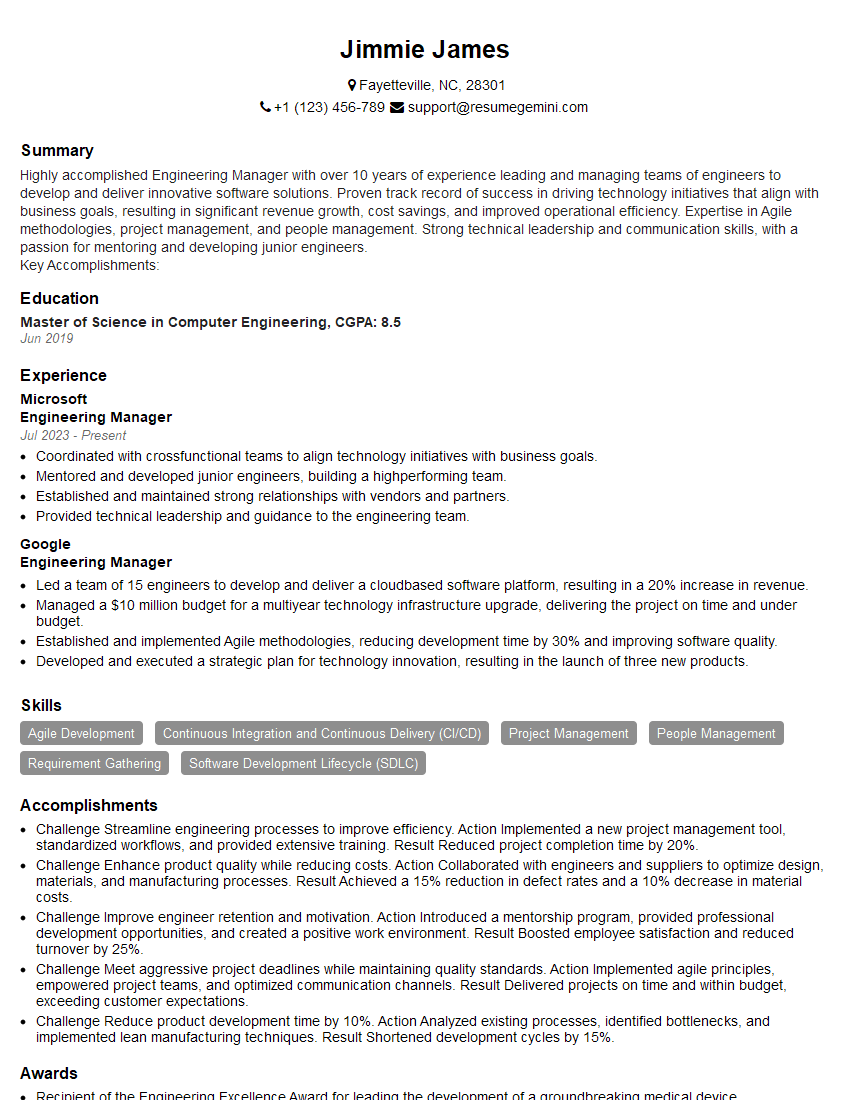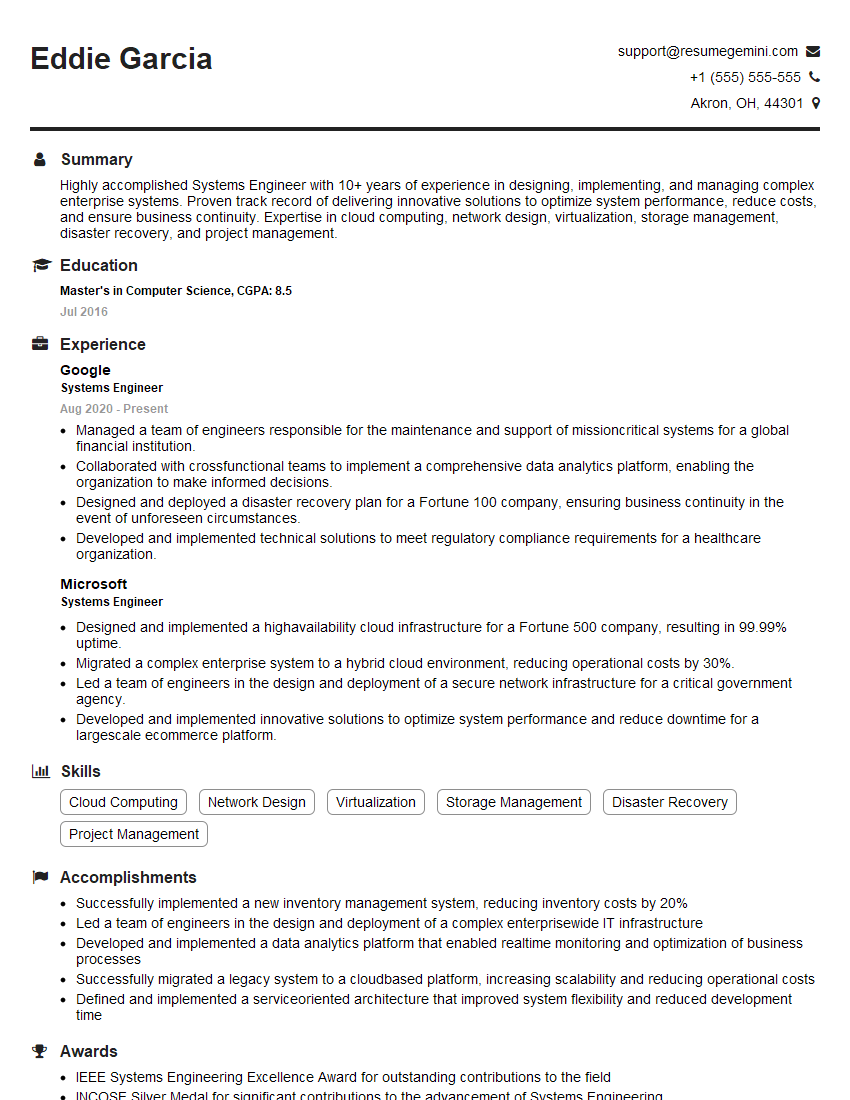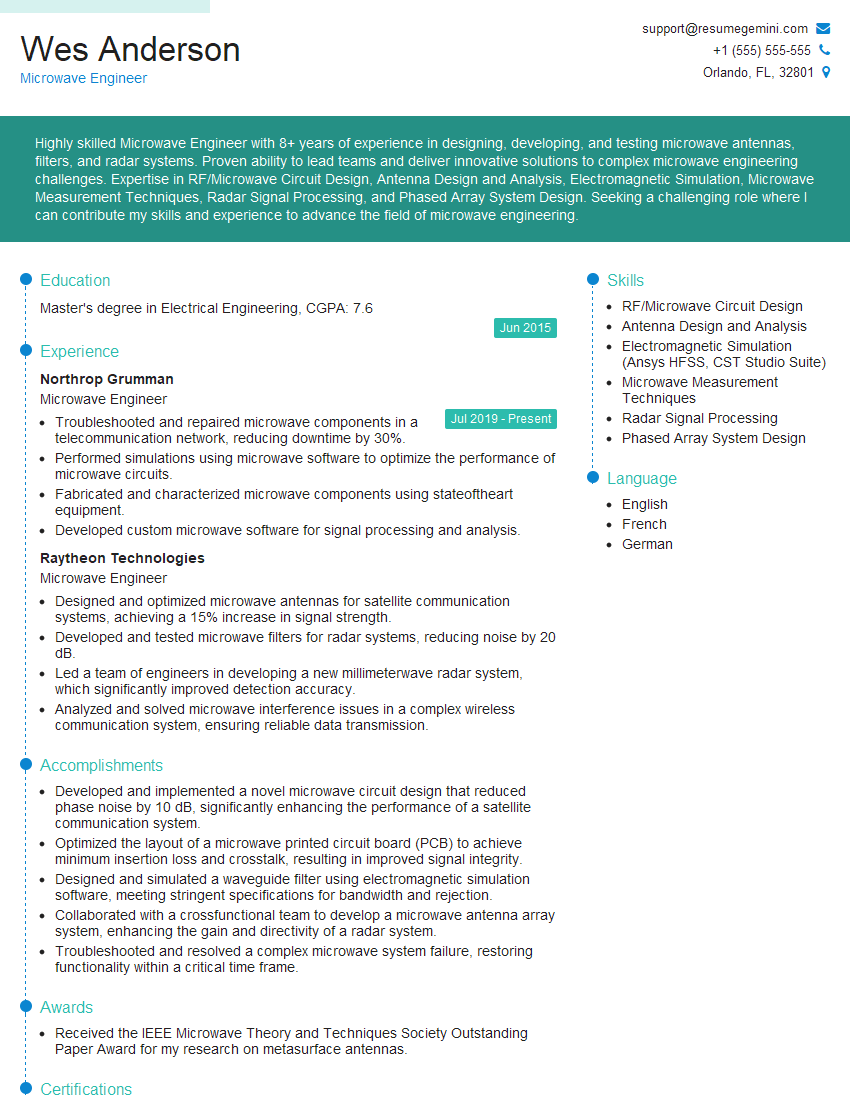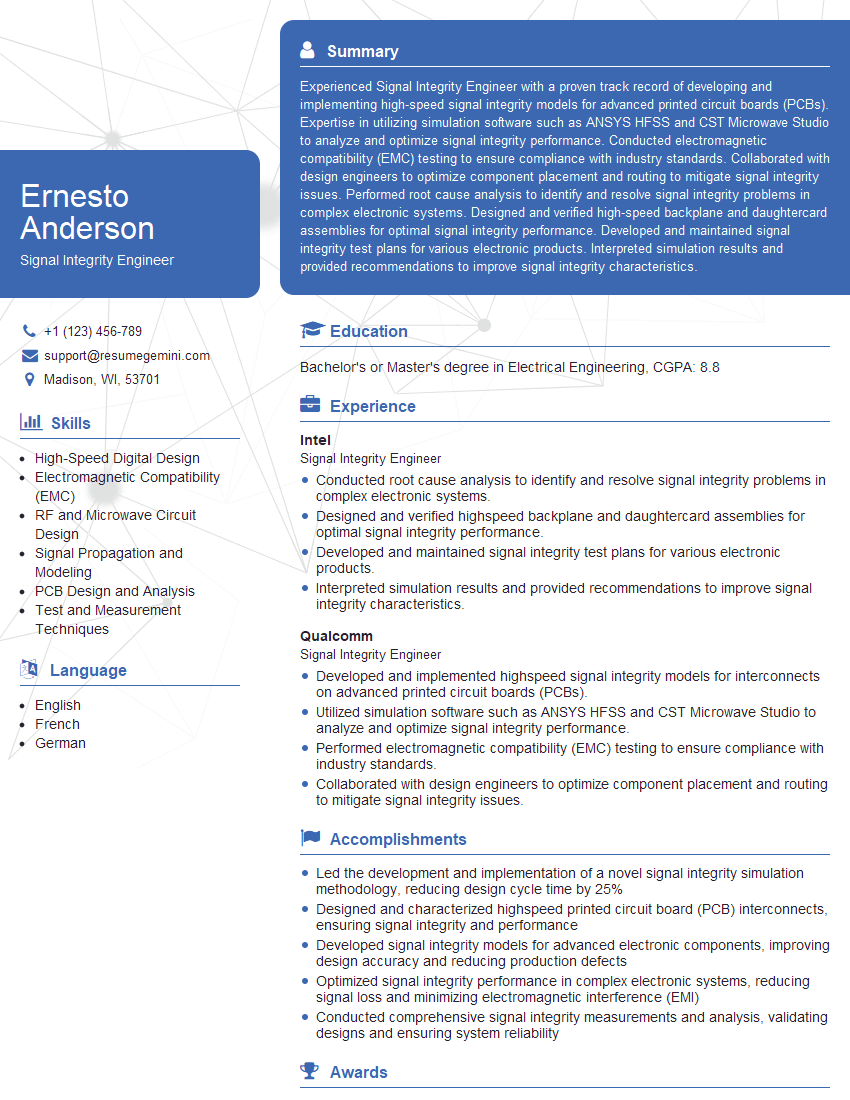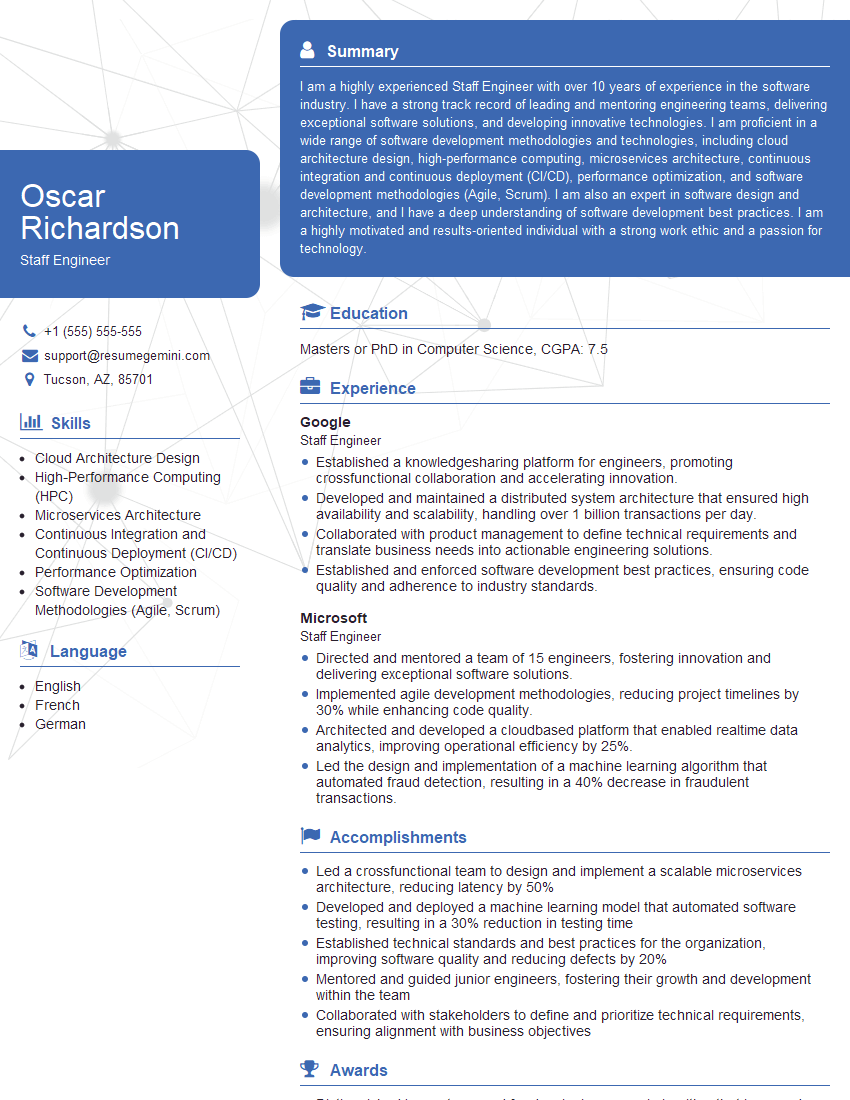Are you ready to stand out in your next interview? Understanding and preparing for Radar Pulse Compression Techniques interview questions is a game-changer. In this blog, we’ve compiled key questions and expert advice to help you showcase your skills with confidence and precision. Let’s get started on your journey to acing the interview.
Questions Asked in Radar Pulse Compression Techniques Interview
Q 1. Explain the purpose of pulse compression in radar systems.
Pulse compression is a clever technique used in radar systems to achieve high range resolution without sacrificing the advantages of transmitting high-energy pulses. Imagine trying to distinguish between two closely spaced objects – like two airplanes very close together. A short pulse provides excellent resolution, allowing us to easily see the separation, but it carries less energy making it harder to detect distant objects. Conversely, a long pulse carries high energy and is great for detecting faraway objects, but its poor resolution means it might not distinguish between the close airplanes.
Pulse compression elegantly solves this: We transmit a long pulse with a specific coded modulation (like a chirp or a phase code). This long pulse enables high energy transmission, improving the signal-to-noise ratio (SNR). Then, upon receiving the reflected signal, we use a matched filter to compress the pulse, effectively recovering the resolution of a much shorter pulse. This gives us the ‘best of both worlds’ – high energy for detection and high resolution for accurate ranging.
Q 2. Describe the difference between linear frequency modulation (LFM) and phase-coded waveforms.
Both Linear Frequency Modulation (LFM) and phase-coded waveforms are used in pulse compression to achieve high range resolution, but they differ in how they modulate the transmitted pulse. LFM, also known as a chirp, uses a linearly increasing or decreasing frequency across the pulse duration. Picture a bird’s chirp – it starts at one frequency and smoothly increases or decreases over time. This continuous frequency variation encodes range information within the pulse.
Phase-coded waveforms, in contrast, use discrete phase shifts to encode the pulse. Imagine a sequence of switches that alter the phase of the carrier wave in a specific pattern. Each phase shift represents a bit of information, and the pattern is carefully chosen to have good autocorrelation properties (high peak, low sidelobes).
Therefore, LFM uses a continuous frequency modulation for encoding, while phase-coded waveforms use discrete phase shifts. This difference leads to variations in their performance characteristics, as we’ll see later.
Q 3. What are the advantages and disadvantages of using LFM waveforms?
LFM waveforms offer several advantages, making them a popular choice in many radar applications:
- Simple implementation: LFM signals are relatively straightforward to generate and process.
- Good range resolution: They provide excellent range resolution after pulse compression.
- High processing gain: The matched filter can significantly improve the signal-to-noise ratio.
However, there are some disadvantages:
- Sensitivity to Doppler shifts: Large Doppler shifts can significantly degrade the performance of LFM systems, leading to range-Doppler coupling.
- Sidelobes: The compressed pulse has sidelobes, which can cause clutter and false targets.
- Bandwidth limitations: The required bandwidth can be substantial, limiting its application in certain frequency bands.
The choice of waveform depends on the specific requirements of the radar system, balancing the trade-offs between these advantages and disadvantages.
Q 4. How does matched filtering work in pulse compression?
Matched filtering is the heart of pulse compression. It’s a signal processing technique that maximizes the signal-to-noise ratio (SNR) by correlating the received signal with a replica of the transmitted signal. Think of it as a ‘template matching’ process. We have a specific ‘template’ (the transmitted pulse’s waveform) and we slide it along the received signal, looking for the best possible match.
In pulse compression, the received signal is passed through a filter whose impulse response is the time-reversed complex conjugate of the transmitted waveform. This filter is known as the matched filter. The output of the matched filter is the compressed pulse, which is much shorter than the original transmitted pulse but with the same energy. This compression enhances the range resolution and improves detection.
Mathematically, the output is given by the convolution of the received signal with the impulse response of the matched filter. This process concentrates the energy of the signal into a narrow peak, highlighting the target’s range while suppressing noise.
Q 5. Explain the concept of range resolution and its relationship to pulse compression.
Range resolution refers to the ability of a radar system to distinguish between two targets located at different ranges. The key is the ability to separate their return signals. A finer range resolution translates to a better ability to distinguish closely spaced targets.
Pulse compression significantly improves range resolution. While the transmitted pulse might be long, the compressed pulse is significantly shorter. The range resolution is approximately proportional to the inverse of the bandwidth of the transmitted signal. This means a wider bandwidth (such as achieved with the frequency sweep of LFM) provides a higher range resolution, enabling us to distinguish between targets that are very close to each other.
For example, a radar system with a 10 MHz bandwidth can achieve a range resolution of approximately 15 meters (in free space). By increasing the bandwidth through pulse compression, we can obtain much better range resolution, even for long transmitted pulses.
Q 6. What is the ambiguity function, and how is it used in pulse compression design?
The ambiguity function is a crucial tool in pulse compression design. It’s a two-dimensional function that describes the correlation between a signal and its delayed and Doppler-shifted versions. In simpler terms, it depicts how well the radar can distinguish between targets at different ranges and velocities.
The ambiguity function helps us understand the trade-offs involved in pulse compression waveform selection. A ‘good’ waveform will have a sharp peak in the ambiguity function at zero delay and zero Doppler shift, indicating good range and velocity resolution, and low sidelobes to minimize range and Doppler ambiguities.
By analyzing the ambiguity function, designers can select waveforms that minimize ambiguities (false targets) and optimize the radar’s performance based on the specific application. For example, for a radar needing to identify targets in a dense environment, a waveform with low sidelobes would be highly desirable.
Q 7. Describe different types of phase-coded waveforms and their properties (e.g., Barker codes, polyphase codes).
Several types of phase-coded waveforms are used in pulse compression. Each has its own advantages and disadvantages:
- Barker codes: These are binary phase-coded sequences with good autocorrelation properties (low sidelobes). They are relatively short, limiting their range resolution, but simple to implement. Example:
[1, 1, 1, -1, 1, -1, -1, 1] - Polyphase codes: These utilize more than two phases (e.g., 4, 8, or more). They can achieve lower sidelobes compared to Barker codes and better range resolution due to greater processing gain, while demanding higher complexity in generation and processing. Frank codes and P4 codes are common examples.
- Complementary codes: Pairs of codes are designed such that the sum of their autocorrelation functions has very low sidelobes. This is useful for reducing sidelobe interference, but requires a more complex signal processing strategy.
The selection of the phase-coded waveform is driven by the desired sidelobe level, range resolution, and complexity constraints of the specific radar application. Polyphase codes are often preferred for their ability to achieve high range resolution and low sidelobes in modern radar systems.
Q 8. How does Doppler processing affect pulse compression?
Doppler processing and pulse compression are intertwined in radar systems. Pulse compression aims to improve range resolution by using a long, coded waveform, while Doppler processing aims to measure the radial velocity of targets. When a target moves, the received signal’s frequency shifts due to the Doppler effect. This shift affects the compressed pulse. Imagine trying to compress a musical chord – if one note is slightly off-pitch, the compressed result (the clearly distinguished individual notes) will be less clean. Similarly, Doppler shifts can introduce distortions or smearing in the compressed pulse, especially for high-speed targets. The impact depends on the target velocity and the pulse compression technique used. For instance, in moving target indication (MTI) radars, Doppler processing is employed before pulse compression to mitigate the effects of clutter, leading to a cleaner pulse compression result, but this process requires careful consideration of the interaction between the two. Advanced techniques like Range-Doppler processing combine both to achieve excellent range and velocity resolution.
Q 9. Explain the impact of noise on pulse compression performance.
Noise significantly degrades pulse compression performance. Think of it like trying to hear a whispered message in a noisy room – the message (the compressed signal) gets harder to distinguish from the background noise. In radar, noise manifests as unwanted signals from various sources, such as thermal noise, atmospheric interference, and clutter. This noise adds to the received signal, making it more difficult to achieve a high signal-to-noise ratio (SNR) after pulse compression. The quality of the compressed pulse is directly affected. A low SNR results in a weaker, less defined compressed pulse, potentially leading to missed detections or inaccurate range measurements. The impact of noise is typically reduced by employing techniques like matched filtering (which maximizes the SNR) and coherent integration, accumulating multiple pulses to improve the SNR. The effectiveness of these techniques depends on the statistical properties of the noise and the design of the pulse compression waveform.
Q 10. Describe techniques for compensating for range walk in pulse compression.
Range walk is a phenomenon where the target’s echo appears to shift its position in range during the transmission of a long pulse. It occurs because the target’s distance changes significantly over the duration of the transmitted waveform. Imagine a bird flying across the radar beam – its position changes during the time it takes for the radar to send and receive a long pulse. This introduces smearing and loss of resolution in the compressed signal. Several techniques compensate for range walk. These include:
- Phase correction: Calculating and compensating for the phase shift introduced by range walk during the pulse compression process.
- Time-varying matched filtering: Designing a matched filter whose impulse response changes in time, accounting for the varying range delay.
- Range migration algorithms: Employing sophisticated algorithms (like the Keystone transform) that explicitly address the range migration effects and redistribute the energy across range bins in the compressed output.
The choice of technique often depends on the radar system’s design parameters and performance requirements. For example, phase correction is simpler but less effective for large range walks, while more complex algorithms provide better compensation at the cost of higher computational complexity.
Q 11. How do you design a pulse compression system for a specific application?
Designing a pulse compression system involves several key considerations, tailored to the specific application. Imagine designing a radar system for autonomous driving – the requirements differ greatly from a weather radar. Here’s a step-by-step approach:
- Define requirements: Specify the desired range resolution, unambiguous range, bandwidth, and maximum Doppler shift (related to target velocity).
- Choose waveform: Select an appropriate waveform (e.g., Linear Frequency Modulation – LFM, Barker code, etc.) based on the requirements. LFM signals are prevalent due to their excellent performance.
- Design the matched filter: Design a filter matched to the chosen waveform to maximize signal-to-noise ratio after compression. This often involves digital signal processing techniques.
- Implement the system: Implement the chosen pulse compression scheme on a suitable hardware platform, considering factors like processing speed and memory limitations.
- Test and optimize: Test the system’s performance thoroughly and refine parameters as necessary to meet specifications.
Real-world examples include using LFM for high-resolution ground-penetrating radars or Barker codes for simpler systems demanding less processing power. The design process needs a careful balance between range resolution (requiring larger bandwidth), unambiguous range (determined by pulse repetition frequency), and practical hardware limitations.
Q 12. What are the challenges in implementing pulse compression in real-time systems?
Real-time pulse compression poses significant challenges. The main hurdle is the substantial computational load required for processing the large amounts of data generated by long, high-bandwidth waveforms. Achieving real-time processing requires:
- High-speed hardware: Specialized digital signal processors (DSPs), field-programmable gate arrays (FPGAs), or application-specific integrated circuits (ASICs) are often necessary to handle the high data rates.
- Efficient algorithms: Optimized algorithms and data structures are crucial to minimize processing time. Fast Fourier Transform (FFT) algorithms are extensively used in pulse compression.
- Parallel processing: Utilizing parallel processing techniques to distribute the computational burden across multiple processors or cores.
- Memory management: Efficient memory management is essential to handle large data buffers and avoid delays.
Failure to meet real-time constraints leads to signal delays and potentially unusable data. For example, in air traffic control, real-time radar data processing is crucial for collision avoidance, so the processing time must be significantly shorter than the time it takes for aircraft to move dangerously close.
Q 13. Discuss different methods for generating and processing LFM signals.
Linear Frequency Modulation (LFM) signals are the most commonly used waveforms in pulse compression. Generating them involves a time-varying frequency, usually accomplished using analog techniques (e.g., voltage-controlled oscillators) or digital methods (e.g., direct digital synthesis).
Generation: Analog methods offer simplicity but can suffer from limitations in precision and linearity. Digital methods, while more complex, enable precise control over the waveform parameters. Direct Digital Synthesis (DDS) is a widely used digital technique for generating LFM waveforms.
Processing: Processing usually involves matched filtering, often implemented using digital filters. The matched filter correlates the received signal with a replica of the transmitted LFM signal. This correlation process typically utilizes Fast Fourier Transform (FFT) algorithms for efficient computation, leading to a highly compressed pulse with improved range resolution. Other processing techniques, such as chirp-z transform, can also be applied for specialized situations.
For example, in a high-resolution ground-penetrating radar, a digitally generated LFM signal would be transmitted and then processed using FFT-based matched filtering to extract fine-grained information about subsurface structures.
Q 14. Explain the trade-offs between range resolution, bandwidth, and signal-to-noise ratio in pulse compression.
There’s a fundamental trade-off between range resolution, bandwidth, and signal-to-noise ratio (SNR) in pulse compression. Think of it like photography: a higher-resolution image (better range resolution) requires a wider aperture (larger bandwidth), which might let in more unwanted light (noise), potentially reducing image quality (SNR).
- Range Resolution: Improved range resolution requires a larger bandwidth, directly proportional to the inverse of the bandwidth. A wider bandwidth means shorter pulses are used, resulting in higher range resolution.
- Bandwidth: Increasing the bandwidth enhances range resolution but also increases noise power. The noise is generally proportional to the square root of the bandwidth.
- SNR: A higher SNR is generally desirable, but it’s influenced by the bandwidth and signal power. A wider bandwidth can increase noise, potentially reducing the SNR unless the signal power is increased accordingly.
Therefore, the optimal choice depends on the specific application. For example, a high-resolution radar might prioritize range resolution, accepting a potential reduction in SNR if sufficient signal power is available. Conversely, a long-range radar system might prioritize SNR and unambiguous range, choosing a narrower bandwidth.
Q 15. How do you assess the performance of a pulse compression system?
Assessing the performance of a pulse compression system hinges on evaluating key metrics that reflect its ability to achieve high range resolution while maintaining adequate signal-to-noise ratio (SNR). We primarily look at the following:
- Range Resolution: This measures the system’s ability to distinguish between closely spaced targets. A sharper mainlobe in the compressed pulse indicates better range resolution. We often express this in meters.
- Sidelobe Level: Strong sidelobes can mask weak targets near strong ones (clutter). We aim for low sidelobes, typically expressed in dB relative to the mainlobe peak. A lower sidelobe level is better.
- Output SNR: The ratio of the signal power to noise power at the output of the matched filter. A higher SNR indicates better target detection capability.
- Compression Ratio: The ratio of the uncompressed pulse width to the compressed pulse width. A higher compression ratio means a greater improvement in range resolution.
- Peak Sidelobe Ratio (PSLR): The ratio of the peak sidelobe amplitude to the mainlobe amplitude. A lower PSLR value indicates better performance.
For example, if a system achieves a range resolution of 1 meter with a PSLR of -30dB and a high output SNR, it would be considered a high-performing system. These metrics are typically measured through simulations and real-world testing using calibrated targets and noise sources.
Career Expert Tips:
- Ace those interviews! Prepare effectively by reviewing the Top 50 Most Common Interview Questions on ResumeGemini.
- Navigate your job search with confidence! Explore a wide range of Career Tips on ResumeGemini. Learn about common challenges and recommendations to overcome them.
- Craft the perfect resume! Master the Art of Resume Writing with ResumeGemini’s guide. Showcase your unique qualifications and achievements effectively.
- Don’t miss out on holiday savings! Build your dream resume with ResumeGemini’s ATS optimized templates.
Q 16. What are the effects of different window functions on pulse compression performance?
Different window functions applied to the transmitted pulse before modulation significantly impact pulse compression performance by trading off between range resolution and sidelobe level. Think of it like shaping the ‘bell curve’ of the compressed pulse.
- Rectangular Window: This offers the best range resolution but suffers from high sidelobes, potentially masking weak targets. Imagine a very sharp, tall peak but with significant ripples around it. It’s simple to implement but not ideal in most real-world applications.
- Hamming Window: Provides a good compromise between range resolution and sidelobe suppression. It reduces sidelobe levels considerably compared to the rectangular window, at a cost of slightly wider mainlobe (slightly lower resolution).
- Hanning (or Hann) Window: Similar to Hamming but with slightly lower sidelobes and even poorer resolution.
- Blackman Window: Offers even lower sidelobes at the expense of further degradation in range resolution.
The choice of window function depends heavily on the specific application requirements. If detecting weak targets in a cluttered environment is paramount, a window with very low sidelobes like the Blackman window might be preferred, even if it means sacrificing a small amount of range resolution. In situations where precise range measurements are critical, and clutter is not a major concern, a rectangular window may be sufficient.
Q 17. Discuss the impact of system imperfections (e.g., phase errors, timing jitter) on pulse compression.
System imperfections significantly degrade pulse compression performance, often leading to reduced range resolution and increased sidelobes. Let’s examine the impact:
- Phase Errors: Errors in the phase of the transmitted and received signals broaden the mainlobe and increase sidelobes. This resembles blurring the compressed pulse, making it harder to pinpoint target range accurately. Sources include imperfections in the transmitter, receiver, and propagation path (e.g., multipath).
- Timing Jitter: Random variations in the timing of the transmitted and received pulses also degrade performance. It effectively introduces uncertainty in the timing of the signal, smearing the compressed pulse in the time domain. This results in range resolution loss and increased sidelobes. The severity depends on the magnitude of the jitter relative to the compressed pulse width.
- Frequency Errors: Inherent imperfections or drift in the oscillators that generate the transmitted waveform can cause mismatches in the compression process, broadening the mainlobe and increasing sidelobes.
Mitigation strategies include sophisticated signal processing techniques such as phase correction algorithms, careful calibration of system components, and the use of stable oscillators. Advanced pulse compression techniques, such as those using adaptive filtering, can also help compensate for these errors to some extent. Minimizing these errors is crucial to maintain high performance.
Q 18. Explain how pulse compression is used in different types of radar systems (e.g., automotive radar, weather radar).
Pulse compression finds widespread use in various radar systems, adapting to specific application needs:
- Automotive Radar: Used for adaptive cruise control, collision avoidance, and blind spot detection. Here, high range resolution is crucial to distinguish between closely spaced vehicles or objects, while the relatively short range simplifies the design. Often, lower-cost systems with simpler pulse compression techniques are acceptable due to the shorter operational range.
- Weather Radar: Employed to detect and monitor precipitation, wind speed, and other atmospheric phenomena. High range resolution is essential to precisely determine the location and intensity of precipitation cells. The long range necessitates the use of high-power transmitters and advanced signal processing techniques to compensate for atmospheric attenuation and clutter.
- Airborne Radar: Used in applications like air traffic control and surveillance. This requires high resolution to resolve many targets at significant distances. High precision is required, typically using advanced pulse compression techniques to mitigate the effects of Doppler shift and clutter.
- Spaceborne Radar: Used for Earth observation, mapping, and remote sensing. Long ranges and high resolution are needed, demanding sophisticated pulse compression schemes to achieve optimal performance.
In each of these applications, the specific pulse compression technique employed is optimized to meet the system’s requirements regarding range resolution, sidelobe level, and cost.
Q 19. What are some advanced pulse compression techniques (e.g., nonlinear frequency modulation, frequency hopping)?
Beyond the basic linear frequency modulation (LFM) chirp, several advanced pulse compression techniques offer improved performance in challenging scenarios:
- Nonlinear Frequency Modulation (NLFM): Provides better sidelobe suppression compared to LFM by employing a nonlinear frequency sweep. This helps to reduce the energy in the sidelobes and improves target detection, especially in environments with high clutter. The design and implementation are more complex than LFM.
- Frequency Hopping: The carrier frequency is rapidly changed in a pseudorandom sequence. This is useful in environments with significant jamming or interference because the signal’s energy is spread across the frequency spectrum. The challenge is to accurately demodulate the signal after it’s received.
- Phase Coded waveforms: These use binary codes to phase modulate the transmitted waveform. Barker codes and polyphase codes are common examples. These are easily implemented with digital signal processing. They offer good range resolution but their sidelobe levels may be higher than NLFM.
- Adaptive Pulse Compression: Techniques that dynamically adjust the compression filter to compensate for time-varying channel conditions (like multipath propagation). These are more computationally intensive but highly beneficial in dynamic environments.
The selection of an advanced technique depends heavily on the operating environment and the trade-offs between sidelobe suppression, range resolution, complexity, and computational cost. For example, NLFM might be chosen in a highly cluttered environment, whereas frequency hopping could be better in a jamming scenario.
Q 20. How can you improve the range resolution of a radar system using pulse compression?
Pulse compression dramatically improves range resolution without increasing peak power. Remember that the range resolution of a conventional radar is limited by the pulse width. By transmitting a long pulse with a wide bandwidth and then using a matched filter for compression, we effectively achieve the range resolution associated with a much shorter pulse.
The key is that the range resolution is primarily determined by the signal bandwidth, not the pulse duration. A longer pulse with a wide bandwidth, after compression, will deliver a much better resolution than a short pulse with a narrow bandwidth. This allows for a higher average power which improves the detection of weak targets, without the range resolution penalty associated with a longer pulse.
Q 21. Describe the relationship between pulse width, bandwidth, and range resolution.
The relationship between pulse width (τ), bandwidth (B), and range resolution (ΔR) is fundamental in pulse compression. In an ideal system, the range resolution is inversely proportional to the bandwidth:
ΔR ≈ c / (2B)
where c is the speed of light. This means that a wider bandwidth leads to finer range resolution. The pulse width (τ) is related to the time-bandwidth product (TBP) and is largely dictated by the bandwidth and the type of pulse compression employed. The transmitted pulse can be much longer than the final compressed pulse resolution.
For example, a pulse with a bandwidth of 10 MHz will provide a range resolution of approximately 15 meters (c/(2*10MHz)). We can achieve this resolution with a long pulse (e.g., 100 microseconds), then compress it through a matched filter, offering a high average power while maintaining fine range resolution.
Q 22. Explain how to choose appropriate parameters for pulse compression (e.g., pulse width, bandwidth, coding scheme).
Choosing the right parameters for pulse compression is crucial for optimal radar performance. It’s like choosing the right lens for a camera – the wrong settings lead to blurry images (poor range resolution).
The key parameters are pulse width (τ), bandwidth (B), and the coding scheme. These are interconnected; you can’t just pick one arbitrarily. The time-bandwidth product (TBP = τB) determines the processing gain, which improves the signal-to-noise ratio (SNR) and allows for the detection of weaker targets.
- Pulse Width (τ): A shorter pulse width provides better range resolution (the ability to distinguish between closely spaced targets). However, shorter pulses mean lower energy, reducing detection range.
- Bandwidth (B): A wider bandwidth provides better range resolution. Wider bandwidths often require more complex and expensive hardware.
- Coding Scheme: This defines how the transmitted pulse is modulated. Common schemes include linear frequency modulation (LFM, also known as chirp), phase-coded waveforms (e.g., Barker codes, polyphase codes), and more advanced techniques. The choice depends on factors like desired range resolution, sidelobe levels, and complexity of implementation. LFM is popular due to its relatively simple implementation and good performance. Polyphase codes offer better sidelobe suppression for improved clutter rejection.
Example: For a radar needing high range resolution to distinguish between closely spaced aircraft, you might choose a short pulse width (e.g., 1 μs) and a wide bandwidth (e.g., 100 MHz), potentially using an LFM waveform. For a longer-range radar prioritizing detection range, a longer pulse width and narrower bandwidth might be more appropriate.
The design process often involves trade-offs. For instance, increasing bandwidth improves range resolution but may necessitate higher sampling rates and more complex signal processing.
Q 23. Describe methods for detecting targets in the presence of clutter using pulse compression.
Detecting targets amidst clutter using pulse compression involves leveraging the improved signal-to-clutter ratio (SCR) achieved by the compression process. Clutter refers to unwanted radar reflections from things like ground, sea, weather, etc.
- Matched Filtering: This is the core technique. The received signal is correlated with a replica of the transmitted waveform (the matched filter). This process significantly enhances the target signal relative to noise and clutter.
- Moving Target Indication (MTI): MTI filters can be incorporated before or after pulse compression to suppress stationary clutter. These filters exploit the Doppler shift caused by moving targets. MTI utilizes techniques like canceling consecutive pulses or employing more sophisticated digital filtering methods like recursive filters or FFT-based filtering.
- Clutter Map Subtraction: A clutter map can be created from prior scans. This map represents the average clutter return for each range and Doppler bin. Subtracting this map from subsequent returns helps remove persistent clutter.
- Space-Time Adaptive Processing (STAP): STAP is an advanced technique that uses both spatial and temporal information to suppress clutter. It’s particularly effective in airborne radar systems.
Example: In an airborne radar, clutter from the ground is significant. Pulse compression improves target detection by increasing the SNR. However, further clutter suppression is needed. An MTI filter removes stationary ground clutter, while STAP might be employed to handle more complex clutter scenarios.
Q 24. How can you mitigate the effects of multipath propagation on pulse compression performance?
Multipath propagation, where the transmitted signal reaches the receiver via multiple paths (direct, ground reflection, etc.), creates ghost targets and degrades range accuracy. Mitigation techniques include:
- Space-Time Processing: Utilizing multiple antennas and advanced signal processing techniques to estimate the different propagation paths and their delays. This allows for resolving the true target from the multipath returns.
- Frequency Diversity: Transmitting at multiple frequencies can reduce the impact of multipath, as different frequencies experience different multipath effects. Processing the received signals from different frequencies helps separate true targets from multipath interference.
- Advanced Waveform Design: Certain waveform designs, such as low autocorrelation sidelobe waveforms, can help mitigate the impact of multipath by reducing the interference from delayed copies of the signal.
- Adaptive Filtering: Using adaptive filters to suppress the multipath interference. The filter coefficients are updated based on the characteristics of the received signal.
Example: In a maritime radar system, reflections from the sea surface cause severe multipath. Employing space-time processing with an array of antennas and advanced signal processing algorithms would be highly effective to distinguish the true target from the sea surface reflections.
Q 25. Discuss the role of digital signal processing in pulse compression.
Digital Signal Processing (DSP) is fundamental to modern pulse compression. It handles all aspects, from waveform generation and transmission to reception, signal processing, and target detection.
- Waveform Generation: DSP generates the coded waveform (e.g., LFM chirp) digitally before converting it to an analog signal for transmission.
- Matched Filtering: The heart of pulse compression, matched filtering is implemented digitally using efficient algorithms (e.g., FFT-based correlation) for fast processing.
- Clutter and Multipath Mitigation: DSP algorithms (e.g., MTI, STAP, adaptive filtering) are used to suppress unwanted signals.
- Target Detection and Tracking: DSP provides algorithms for detecting targets within the processed data and tracking their movement.
Example: The generation of an LFM chirp, its digital mixing with the received signal, and the subsequent FFT-based correlation are all tasks efficiently handled by DSP. Advanced techniques like STAP also heavily rely on DSP’s computational power.
Q 26. Explain how to design and implement a pulse compression system using a specific DSP platform.
Designing and implementing a pulse compression system using a specific DSP platform (e.g., a Texas Instruments TMS320C6000 DSP) involves several steps:
- System Requirements Definition: Define parameters like range resolution, bandwidth, processing gain, etc., based on application needs.
- Algorithm Selection: Choose appropriate algorithms for pulse compression (matched filtering), clutter mitigation, and target detection.
- Hardware Selection: Select the DSP platform and any necessary peripherals (e.g., ADCs, DACs). Consider factors like processing power, memory capacity, and I/O interfaces.
- Software Development: Develop the DSP code in a suitable language (e.g., C/C++) to implement the selected algorithms. This involves efficient coding for real-time performance.
- Testing and Verification: Thorough testing using simulated and real-world data is crucial to verify the system’s performance.
Example: A system could use the TMS320C674x DSP, which has high processing capabilities. The code would implement an LFM pulse compression algorithm using the FFT. The ADC would sample the received signal, the DSP would perform the processing, and the detected targets’ information would be output through a suitable interface.
Implementing this on a specific platform requires familiarity with the platform’s architecture, APIs, and development tools.
Q 27. What are some common errors to avoid when designing or implementing a pulse compression system?
Common errors in pulse compression system design and implementation include:
- Insufficient Sampling Rate: If the sampling rate is too low (Nyquist criterion violation), crucial high-frequency components of the signal will be lost, leading to inaccurate results.
- Ignoring Sidelobes: High sidelobes from the compression process can mask weak targets or create false alarms. Careful waveform design and sidelobe suppression techniques are vital.
- Inadequate Clutter Mitigation: Failing to properly address clutter can overwhelm the target signal, making detection impossible.
- Poor Calibration: Inaccurate calibration of the hardware components (e.g., ADCs, DACs) can lead to significant errors in the processed data.
- Insufficient Dynamic Range: If the system lacks sufficient dynamic range, weak signals can be lost amidst strong signals.
- Neglecting Quantization Effects: The finite precision of digital representations can lead to quantization noise that degrades system performance. Careful bit allocation is crucial.
Careful planning, simulation, and thorough testing are essential to avoid these errors.
Q 28. Describe your experience with different radar simulation software and tools.
Throughout my career, I have extensively used several radar simulation software and tools, including MATLAB with its signal processing toolbox, and specialized radar simulation packages like [Mention specific software like CST Microwave Studio or similar relevant software]. MATLAB is invaluable for algorithm development, testing, and analysis. Specialized packages offer more sophisticated models for antenna characteristics, propagation effects, and target scattering. I’m comfortable using these tools to simulate diverse radar scenarios and evaluate the performance of different pulse compression techniques under various conditions, including different clutter and multipath environments.
My experience encompasses using these tools to design and simulate systems, from simple linear FM pulse compression to advanced space-time adaptive processing algorithms. I can model various waveform shapes and analyze their performance metrics, such as range resolution, sidelobe levels, and processing gain, with different parameters and in the presence of noise and interference. This allows me to optimize designs before actual hardware implementation, saving considerable time and resources.
Key Topics to Learn for Radar Pulse Compression Techniques Interview
- Fundamentals of Pulse Compression: Understanding the basic principles, including the trade-off between range resolution and signal-to-noise ratio. Explore various waveform designs and their impact.
- Matched Filtering: Deep dive into the theory and application of matched filters for optimal signal detection and pulse compression. Understand the relationship between the transmitted waveform and the matched filter.
- Waveform Design Techniques: Familiarize yourself with common pulse compression waveforms like linear frequency modulation (LFM), phase-coded waveforms, and their respective advantages and disadvantages. Analyze their ambiguity functions.
- Practical Applications: Explore real-world applications of pulse compression in various radar systems, including weather radar, air traffic control, and automotive radar. Consider specific challenges and solutions in each application.
- Range Resolution and Ambiguity Function: Master the concepts of range resolution and the ambiguity function, understanding how they are affected by waveform design and system parameters. Be prepared to analyze and interpret ambiguity diagrams.
- Digital Signal Processing (DSP) Techniques: Gain a strong understanding of the DSP algorithms used for pulse compression, such as Fast Fourier Transforms (FFTs) and correlation techniques. Be prepared to discuss their computational efficiency and limitations.
- Clutter Rejection and Interference Mitigation: Understand the challenges posed by clutter and interference in radar systems and explore techniques used in conjunction with pulse compression to mitigate their effects. Discuss Moving Target Indication (MTI) and other relevant techniques.
- System Design Considerations: Explore the practical implications of pulse compression on radar system design, including transmitter power, receiver sensitivity, and overall system performance. Be prepared to discuss trade-offs and optimization strategies.
Next Steps
Mastering Radar Pulse Compression Techniques is crucial for career advancement in the field of radar engineering and related disciplines. A strong understanding of these techniques demonstrates a high level of technical expertise and problem-solving skills, making you a highly competitive candidate. To enhance your job prospects, creating an ATS-friendly resume is essential. ResumeGemini is a trusted resource to help you build a professional and impactful resume that highlights your skills and experience effectively. Examples of resumes tailored to Radar Pulse Compression Techniques are available to help guide you. Take the next step towards securing your dream job – build your best resume with ResumeGemini today!
Explore more articles
Users Rating of Our Blogs
Share Your Experience
We value your feedback! Please rate our content and share your thoughts (optional).
What Readers Say About Our Blog
Live Rent Free!
https://bit.ly/LiveRentFREE
Interesting Article, I liked the depth of knowledge you’ve shared.
Helpful, thanks for sharing.
Hi, I represent a social media marketing agency and liked your blog
Hi, I represent an SEO company that specialises in getting you AI citations and higher rankings on Google. I’d like to offer you a 100% free SEO audit for your website. Would you be interested?
